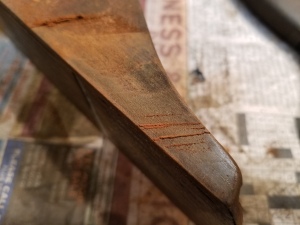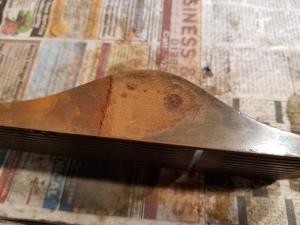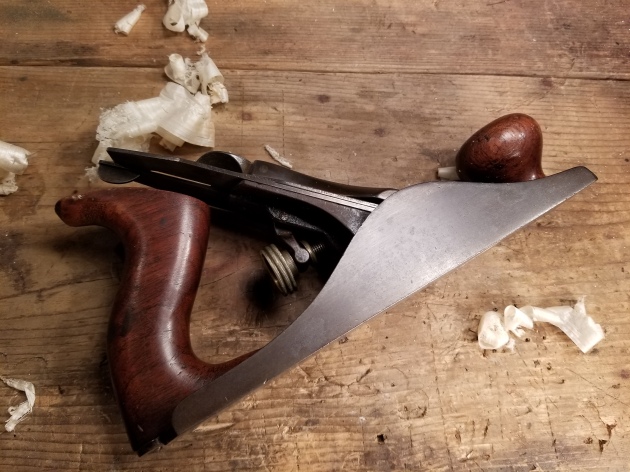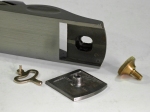 Vintage hand planes are commonly found in the wild with filthy, crud encrusted, cracked, or broken totes and knobs. While I periodically come across a plane with a knob or tote that has an old repair (usually poorly done), most have been left neglected and broken. Correct vintage replacements, especially for Stanley planes, are readily available on Ebay, but they are expensive, often costing as much or more than an entire tool. In my experience, however, most damaged wood components can be restored for use, if not display, with just a little effort and patience.
Vintage hand planes are commonly found in the wild with filthy, crud encrusted, cracked, or broken totes and knobs. While I periodically come across a plane with a knob or tote that has an old repair (usually poorly done), most have been left neglected and broken. Correct vintage replacements, especially for Stanley planes, are readily available on Ebay, but they are expensive, often costing as much or more than an entire tool. In my experience, however, most damaged wood components can be restored for use, if not display, with just a little effort and patience.
In keeping with my overarching philosophy that less is more when it comes to vintage tool preservation, I strive to retain as much of the original finish and character of the wooden components as possible. To that end, I don’t advocate refinishing per se, unless of course the original finish has been destroyed through exposure to the elements, heavy use, or in the course of completing the repair. The very nature of extensive damage (multiple breaks, chips, missing pieces, etc.) will frequently necessitate at least some degree of restoration to the finish itself. However, when the only other alternative is to discard and replace the damaged part, more radical restoration techniques are easily justified.
In the following sections I will take you through the steps and materials required to complete many of the most common repairs to totes and knobs. While there are numerous solutions to any one problem, these are the techniques I have found to produce the most favorable results.
General Cleaning and Preservation
The totes and knobs on many vintage hand planes are perfectly fine just as they are. Unless the tool was never used, virtually all will have some degree of dents, dings and abrasions from time spent in a toolbox. There may also be a few minor chips along edges, specks of paint, and perhaps the initials of the original owner stamped into the surface. The varnish might be crazed and there may be some checks in the grain from age and dryness. And, of course, there may well be layers of dirt, dried oil and grime hiding an otherwise beautiful piece of rosewood. All of this is to be expected.
I don’t need (or necessarily want) my totes and knobs to look pristine, and most of the time the only treatment I give them is a little wax, or if the wood appears dry, a thorough rub down with a hydrating concoction of linseed oil, turpentine, and vinegar (LTV). You can make your own or purchase Kramer’s Best Antique Improver, which I’m pretty sure Mr. Kramer makes at home in his kitchen. Applied with a cotton rag, this all natural solution cleans and nourishes the wood, bringing back is lustrous beauty without petrochemicals, and most importantly, does not alter the finish or surface features at all.
Dirt, Crud, and Paint
For totes and knobs that are structurally sound, but have layers of crud stuck to them (where basic cleaning isn’t enough), I use a very fine synthetic pad or steel wool soaked in the same LTV solution as a lubricant to the abrasive pad. Using very light pressure, I scrub away whatever crud I can. This requires a cautious touch, however, as too much scrubbing can easily damage or remove the original finish. Go slow and repeat if necessary. Don’t try to remove every speck and spot or the piece will start to look refinished. Wipe off the slurry of muck this creates and finish up with a generous application of LTV, polished with a clean cotton cloth.
I like to leave paint specks intact since they are a colorful part of the tool’s history and character, but if you’re determined to remove them, use the same technique described above, but with a little more vigor. This will usually remove most of the tiniest specks. For larger spots, lubricate the wood with turpentine, and very carefully scrape the paint spot off using a card scraper or any tool with a fairly sharp angle. I use a three sided hollow scraper that can be found in most art supply stores. The turpentine provides light lubrication for the scraper, which helps protect the surrounding and underlying finish. This will leave visible scratched spots, so go over the entire piece again with the fine synthetic pad or steel wool lubricated with turpentine or LTV to blend in any marks you made. Finish up with an application of LTV, polished with a clean cloth.
Keep in mind that by doing this you are altering the original finish of the piece, not to mention erasing part of its history. This is a destructive technique, however mild. Once done, it cannot be reversed, so go slow.
Cracks and Breaks
Like everything else, damage is part of the tool’s history. Wooden parts are comparatively fragile, and when tools are used improperly or carelessly, they suffer chips, cracks, and breaks. Age and environment also takes a toll. Once damage occurs (or is found), there are three options available to the owner – leave it as is, repair the damage, or replace the part. If you decide to repair the damage, there are two further considerations – functional stability and visual aesthetic.
Cracks and clean breaks are easy to repair, especially if done right away. Older breaks tend to be literally rougher around the edges, but are still no lost cause. Even the nastiest shattered breaks with multiple shards, splinters, and open gaps can be repaired with surprisingly appealing cosmetic results.
When performing a repair, function trumps form. Making it pretty isn’t of much value if the repair breaks the first time you use the tool. Repairing cracks and breaks necessitates the adherence of two separated pieces of wood, and the obvious solution to that is some sort of adhesive. Anyone making anything out of wood will likely have one of the commercial polyvinyl acetate (yellow wood) glues close by. This is probably the most common type of glue used in woodworking. If you’re a purist you might favor hide glue. The newer polyurethane glues (ex. Gorilla brand) are popular and very strong, but messy. These are just a few of the options available.
I’ve tried just about every type of glue, and have found that 2 part epoxy provides the best results for this particular application. It is quite strong, does not require pressure while curing, cures under a wide range of temperatures, has good gap filling properties, can be filed and sanded, is easily tinted, and accepts a finish.
2 Part epoxy consists of a resin and a hardener. Simply squeeze out an equal measure of both, mix thoroughly, and apply. I tint the epoxy with just a pinch of dry pigment (available at art supply stores) before mixing. I typically use black or raw umber if working on rosewood. It doesn’t take much to tint the epoxy, just a tiny amount. I should note that you can also use very fine rosewood sawdust to tint the epoxy, which works exceptionally well and is naturally a perfect color match.
Mix the epoxy thoroughly and apply liberally to both mating surfaces. Use a razor blade or thin knife to work it into cracks. Clamp tight as best you can remembering it’s actually more important that the pieces stay properly aligned than under a lot of pressure. With this method, you actually want a little squeeze out consistently along the seam to fill any gaps that might remain, so don’t wipe it off. Epoxy starts to set in about 5 minutes, but takes a good 24 hours to cure. Let it fully harden before proceeding.
Once cured, use the scraper or a file to remove the excess epoxy. I use old steel files for this purpose. File sharpness for this sort of woodwork is not as much of concern as it is for metalwork, and old files are plentiful and cheap. You’re going to damage the surrounding finish doing this, but don’t worry, you’ll touch it up later. Nasty breaks or poor alignment during curing may leave some rough spots. Go ahead and reshape these areas using the files or a rasp. Remember to use progressively finer teeth. Once shaped, finish up with 200 to 320 grit sandpaper to remove file marks and help refine shape and edges. At this point there should be no open gaps or holes.
Now you’ll need to repair the finish. Stanley and most competitors used a varnish on their totes and knobs, and fortunately for us, they weren’t too concerned with leaving a furniture grade finish. The finish they imparted was utilitarian and that works in our favor. There are lots of finish options to choose from, but I prefer a penetrating oil and varnish blend, such as Watco Danish Oil Finish. It comes in both tinted and natural versions, which you can tint yourself if desired. Tinting helps hide the epoxy seams and blends well with the existing finish. Follow the directions on the can closely. I apply it to the repaired portions only, slightly overlapping the original finish on adjacent areas. The finish builds up slowly and will require multiple applications. This takes patience and time, but the results are worth it. Once you feel you’re getting close, dry buff the new finish using the fine synthetic pad, blending it with the areas of old finish. Repeat steps with more Watco if necessary. Once the new finish matches the old in overall luster and is completely cured, top it off with a good rub of LTV or wax. Buff to a shine with a cotton cloth. If the new finished area looks dull compared to the original finish, you need to go back and add more coats.
When well executed, breaks and cracks repaired in this manner are not only extremely strong and stable, they are nearly invisible.
Chips and Missing Chunks
Knobs with minor chips around the base and totes with missing or chipped tips are common. Many chips are simply not practical to replace – those along the top edge of the tote’s tip, for example. Others, such as an entire missing horn or a chunk missing from a knob base provide an interesting challenge. The solution is no mystery, however. It’s a matter of filing or sanding a perfectly flat mating surface, attaching a section of replacement wood, reshaping the new piece, and applying a finish.
Often the most frustrating part of the process is finding pieces of matching rosewood to use for the repair. For this I save all the broken totes and knobs I can find to use as scrap. It’s just a matter of cutting a new piece to the approximate size needed for the repair. The most difficult part of the process is creating perfectly flat mating surfaces. As discussed above, the epoxy is somewhat forgiving in its ability to fill gaps, but better mating makes for a stronger joint. The easiest way to accomplish this is by using a motorized disk sander with an adjustable table. If you don’t have one, you can do it by hand using sandpaper adhered to a flat substrate. ¼” or thicker plate glass is best, although I’ve achieved great results using a four dollar 12” x 12” granite surface plate. It just takes a very steady hand.
The glue up process is the same as previously described. Once attached, shape the new section using rasps and files, followed by sandpaper. Apply the finish and you’re done.
Fixing Old Repairs
Fixing poorly executed old repairs frequently present the biggest restoration challenge. It’s easier to do it right the first time than to undo and fix a mistake that was already made. The variety of old repairs you might come across are infinite, so I will speak in general terms.
Begin by removing any nails, screws, or bolts present. Old glue joints can often be softened by gently heating the piece. Just be careful not to get too hot or you’ll ruin the finish, if not set the whole thing on fire! If the old repair joint is bad enough, you might have to cut through it with a band saw to give yourself nice new mating halves, although you do lose a little of the dimension. Some joints are brittle enough to break apart by hand. Others are poorly aligned but extremely strong; you may not be able to get these apart at all. The important thing is to assess and decide up front just how you plan to proceed, then go at it.
If nothing else, a poorly aligned or ugly break repair (that is otherwise stable) can be cosmetically improved by filling the gaps and holes with tinted epoxy. This includes nail and screw holes. Once cured, file and sand it smooth and touch it up with the Watco finish. Where alignment is poor, this may require some fairly aggressive reshaping of surrounding wood, but the results are usually much improved.
Damaged Finishes
On some planes the wood finish is damaged or worn so extensively that the wood appears bare. On others, the finish might be intact but is very faded. Others still, especially those from the 1940s and 50s might have a finish that is heavily crazed and flaking off. It’s very important to determine just what the problem is before attempting a repair. I’ve seen planes on which the wood at first glance looked like a completely lost cause, only to find that a simple cleaning and conditioning brought them back to life. Proceed conservatively until you know what you’re dealing with.
Wood that has lost it finish for whatever reason can be restored following the steps above. If the damage is weather or water related, you may need to sand down the surface before proceeding. If the wood has a lot of open pores, you may get better results by wet sanding with the Watco, especially through the first two or three coats. This creates a slurry that helps fill the pores and seal the wood.
For finishes that are flaking off, the best you can do is remove all the loose finish using the scraper or fine steel wool and turpentine. I’m usually pretty aggressive with this because the flaking reflects something wrong with the original finish itself. A healthy, properly applied finish will not flake off, even after decades. Better to remove all of it and start over.
I don’t mind scars, scratches, and initials, etc. I like the character they provide. If rough, a single application of Watco will help seal the wood, preserving and protecting these features.
Painted and Varnished Hardwood
Stanley used painted hardwood totes and knobs in its planes for a brief period during the 1940s. These are almost always found in terrible cosmetic condition, with chips and areas of loss to the painted finish. After briefly returning to rosewood in the late 1940s and early 1950s, the company switched to heavily varnished hardwood, and then finally to a lighter varnished hardwood in the 1960s.
In my experience, these finishes are virtually impossible to restore in any conservative manner. Short of simply cleaning them, leaving them otherwise as is, the only other thing you can do is to completely refinish them. Unfortunately, refinished wood looks… refinished. If you like your tools to look like new, have at it. I just clean them up as best I can and call it a day.
Loose Totes
Pick up 5 planes and at least one of them will have a loose tote. Have you ever tightened that tote bolt as far as you dare only to find the tote still slips when you go to use it? It seems to be more common in the shorter smoothing planes that don’t have a toe screw in their totes. Perhaps it’s due to wood shrinkage… who knows? Regardless, it’s easy to resolve. Remove the bolt and grind off a millimeter or so to shorten it. Replace the bolt and tighten it down. The tote should now be secure. You might have to do this a couple of times depending on how loose it is.
Suggested Resources
• Turpentine
• Kramer’s Best Antique Improver
• Fine Synthetic Wool Pads
• Fine Steel Wool
• 2 Part Epoxy (5 Min)
• Artists Pigments (Black, Raw Umber, Burnt Sienna)
• 3 Sided Hollow Scraper
• Old Metal Files (Mill, Half Round, Round, etc.)
• Wet/Dry Sandpaper (60 to 320 grits)
• Cotton Rags
• Rosewood scraps

 It’s a slow and methodical process, but the payoff is worth the effort. As you can hopefully see in the photos above, there’s a distinct line where the rust is removed. You can also begin to see the underlying patina on the metal surface, and thankfully in this case, no pitting.
It’s a slow and methodical process, but the payoff is worth the effort. As you can hopefully see in the photos above, there’s a distinct line where the rust is removed. You can also begin to see the underlying patina on the metal surface, and thankfully in this case, no pitting.























